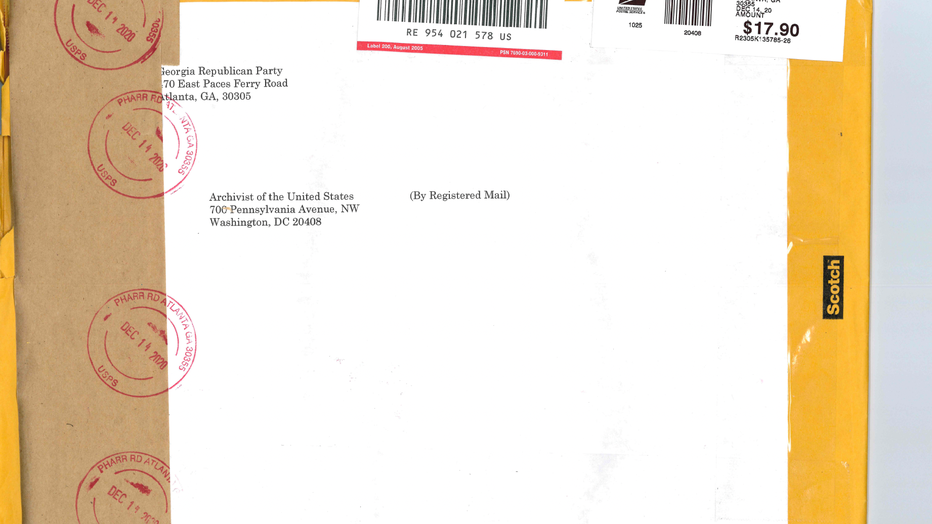3 big differences between 1960 Hawaii electors, 2020 GA Trump electors
Trump indictment: 2020 Georgia vs. 1960 Hawaii
Four days after former President Donald Trump and 18 allies were charged with RICO in Fulton County, many are compare it to an incident during 1960 election between Richard Nixon and John F. Kennedy. During that election, an alternate slate of electors was sent to the Electoral College. However, there are three big difference between the alternate electors of 1960 and the ones in 2020.
ATLANTA - Two close presidential elections 60 years apart. Two states sending dueling slates of electors to Congress.
Did what happened in Hawaii in 1960 set a precedent that allowed Donald Trump supporters in Georgia to do the same in 2020?
That will be the argument for the three "fake electors" indicted this week by a Fulton County grand jury.
Then-state GOP chair David Shafer, Cathy Latham and Shawn Still were among the 16 who gathered December 14, 2020, signing documents mailed to Congress and the Archivist certifying that they were "the duly elected and qualified Electors for President and Vice President of the United States of America from the State of Georgia."

Envelope used by Trump electors to send their "certified votes" to the Archivist and Congress.
District Attorney Fani Willis granted many of the remaining alternate electors immunity and could testify in any future trial.
According to findings from the January 6 Committee, Trump supporters secretly planned to use "fake electors" from Georgia and other states to convince Vice President Mike Pence to accept them instead and make Donald Trump the winner.
At the time, Joe Biden had already been certified as the winner of Georgia’s 16 electoral votes. His electors met and sent their paperwork to Congress, too.
That’s also what happened in Hawaii in 1960. But there are some major differences between the two.
1. Secrecy
Hawaii’s first presidential election as a state was a nail biter — so close, the governor first certified Richard Nixon as the winner over John Kennedy by 141 votes.
Both parties decided to send their own slate of electors to Congress. They did it openly.
Trump electors originally did not. They gathered in Room 216 hoping no one would even know why they were there.
According to this week’s indictment, then-state GOP chairman David Shafer organized the meeting. He sent a text to Individual 4: "Listen. Tell them to go straight to Room 216 to avoid drawing attention to what we are doing."
Robert Sinners, the Trump campaign Georgia Director for Election Day Operations, emailed the alternate electors asking for their "complete discretion."
"At no point should you mention anything to do with Presidential Electors or speak to media."
The meeting was only exposed after independent news commentator George Chidi poked his head through the door. He said they told him it was an "education meeting."
"It was plainly not an education meeting," he said.
Sinners eventually testified to the January 6th committee and the Fulton County Special Purpose Grand Jury.
"I didn’t know at the time that had been, you know, kind of the shadow strategy," he told the January 6th investigators. "And we were kind of useful idiots or rubes at that point."
Sinners said he felt ashamed to be part of the scheme.
"What they did was a little different than Hawaii in that they, like I said, schemed and planned this without the public’s knowledge," said J.Tom Morgan, former DeKalb County District Attorney.
2. Recounts
Hawaii had not finished a partial recount by the time both parties decided to choose their electors.
But on the day Trump electors met, Georgia had already counted its ballots not once, but three times. At the end of each, Joe Biden was still the winner.

3. False allegations of fraud
Neither party suggested wrongdoing in the Hawaii vote count. In Georgia, Trump lawsuits had been routinely dismissed for lack of evidence or standing. Two appeals were pending before the US Supreme Court at the time Shafer gathered his electors.
That’s the reasoning Shafer gave reporters on the day of the meeting, after the true reason for the gathering was made public.
"Because the president’s lawsuit contesting the election has not been decided or even heard, we held this meeting to preserve his rights," Shafer said. "If we had not held the meeting, then his lawsuit would effectively be mooted."
Both Trump lawsuits were dismissed by the U.S. Supreme Court.
Hawaii’s governor eventually certified Kennedy as the state’s winner by 115 votes. And that’s whose slate of electors was chosen by the man who would finish second to Kennedy in the race, Vice President Richard Nixon.

